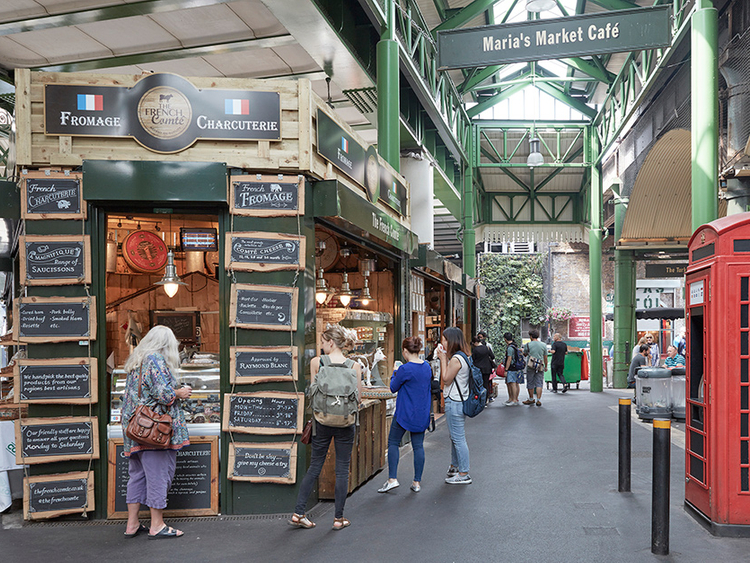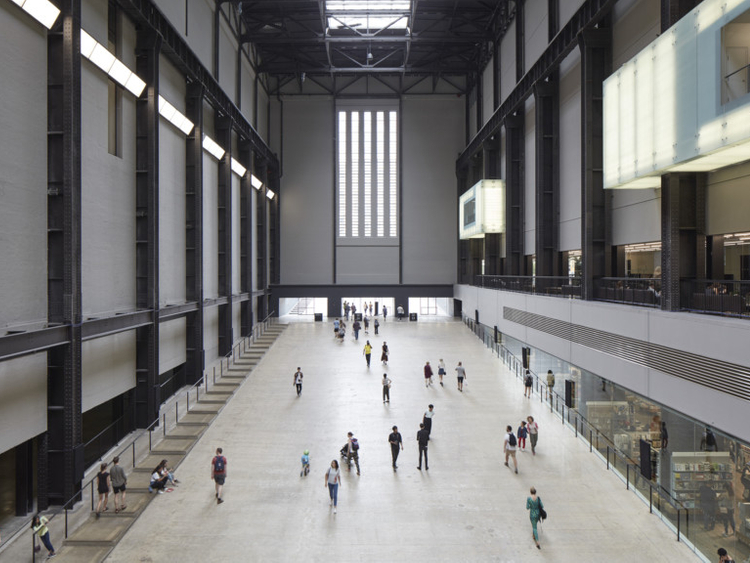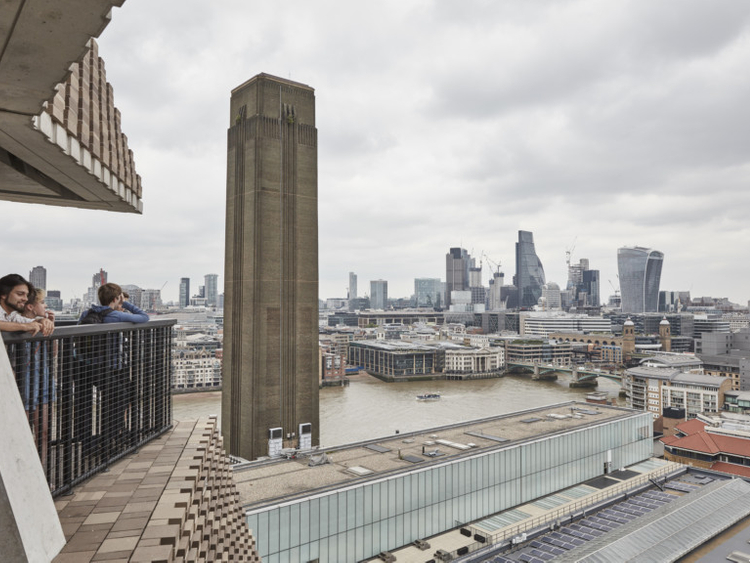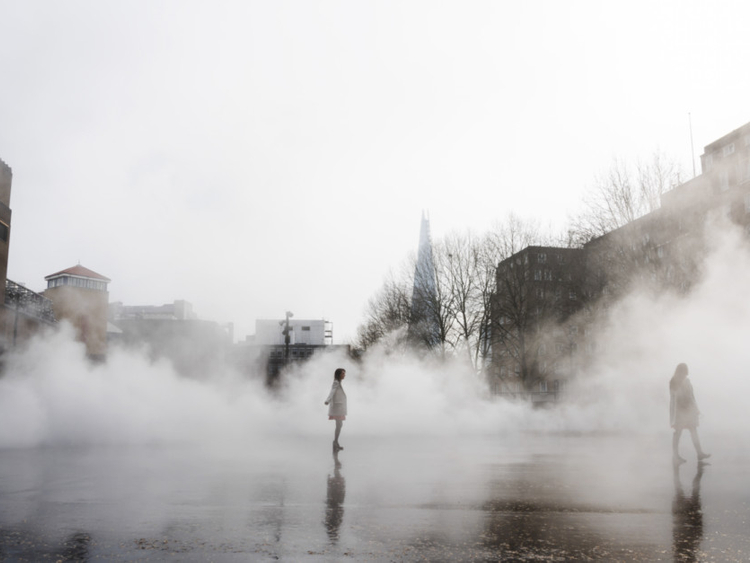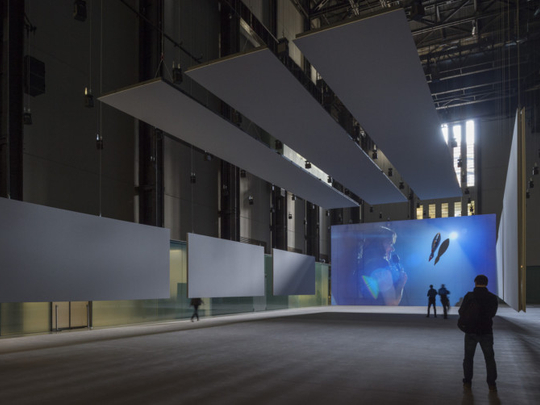
I recently found myself staring into a stranger’s living room, waiting for something beautiful to happen.
I was standing on the 10th-floor viewing terrace of the Tate Modern’s new wing, a twisting ziggurat of perforated brick and mortar that rises above the museum’s home in the old Bankside Power Station. The terrace allows for 360-degree views of the building frenzy that has consumed much of London’s skyline. Cranes dip and dive in every direction; to the east, the Shard, an overwhelming ice pick of a skyscraper, dwarfs the Victorian roofs of the surrounding neighbourhood; to the west, the pregnant monolith of One Blackfriars, a 50-storey mixed-used building, looms over the Thames like an alien mothership. As is the case all over the city, many of its £4 million (Dh19 million) apartments will be scooped up as investments, only to stand empty. Idle butlers will be forced to play solitaire ad infinitum. The future is a lonely place.
Directly across the street, at eye level, was NEO Bankside, three luxury condo towers, their facades crisscrossed in a metric of steel braces. In the nearest tower, no more than 200 feet from where we were standing, rose a series of angular glass living rooms, each meticulously furnished, each empty. In one, three white chairs stood in silent conference. In another, a telescope pointed reproachfully back at us. The only sign of life was a pair of slippers next to an uncomfortable-looking lime-green chaise lounge.
I and my fellow observers were faced with a dilemma. A notice on the viewing terrace asked us to “Please respect our neighbours’ privacy,” yet for the rest of our museum experience, we had been encouraged to look, to question, to interact. The takeaway from the Tate Modern’s new wing, which includes stunning subterranean spaces devoted to performance art, can be summed up as this: Art is not an object but an experience. A museum in the 21st century is no longer just a repository of work but an active house of co-creation. The entire fifth floor of the new building is devoted to Tate Exchange, a flexible space for artists and the public “to collaborate, test ideas and discover new perspectives on life.”
Was the view of abandoned luxury also part of the museum? Did my strange mixture of emotions - the simultaneous curiosity and self-reproach of the voyeur - have a number on the audio tour? Guiltily, I leaned out over the terrace, staring at those slippers. I waited for some kind of performance to begin. I wanted to witness a murder, an affair, a revelation.
This visual standoff offered a perfect distillation of the current battle for London’s soul. As more of these luxury towers spring up across the city, transforming neighbourhoods into affluent ghost towns, Londoners are facing difficult questions: What kind of city do we want to live in? What do we want our streets to look like? What kind of public spaces are valuable to us? Part of the answer to these questions may lie in the entangled story of the Tate Modern and the Bankside neighbourhood it helped spawn.
The museum may be the among the best-known examples of the now fashionable transformation of derelict factories into dynamic cultural space. Since its inception, the Tate Modern has never rested on its laurels, continuing to redefine itself as an institution of outreach, self-reflection and learning. The museum’s evolution over time provides a potential blueprint for how London, and indeed any city, can provide spaces that encourage its inhabitants to be collectively present. You cannot experience the Tate Modern through Facebook or a tweet; you must show up, with an open mind, surrounded by your fellow visitors.
London is perhaps the most international city in the world, but at its heart it has always been a local city, a series of low-slung villages. The expanded Tate Modern embraces this human scale even if its aspirations are more global than ever.
Given the real estate mania that has engulfed Bankside and the surrounding Borough of Southwark, it’s easy to forget what a bold decision it was to shift the center of London’s contemporary art world 17 years ago to a hulking abandoned power station south of the river. Ask any Londoner about wandering amid the postindustrial squalor of Southwark in the late 1980s and you will be regaled by stories of taking life into your own hands.
Everything changed in 2000, when the Tate Modern, the London Eye and the endearingly wobbly Millennium Footbridge all opened to wild, instantaneous acclaim. The Tate Modern received 5.25 million visitors in its introductory year alone. For the first time in years, people crossed the Thames and lingered. And lingered. Urban redevelopment is never a simple formula, but this triumvirate - a wheel, a bridge, a museum - proved an irresistible alchemy that led directly to the area’s renaissance over the next decade and a half.
Reassessing Southwark
If the contemporary city dweller - faced with skyrocketing property values and the scrubbed corporatisation of High Street - spends much time feeling nostalgic for that grittier, more authentic time of low rents and urban blight, then Southwark offers a particularly long and glorious history to savour. Because of its location outside the city gates, Southwark functioned as a refuge for weary travellers of all persuasions. Theatres and playhouses flourished, most famously Shakespeare’s Globe Theatre, as did brothels, bear-baiting pits and breweries. Charles Dickens’ father was jailed for unpaid debts in Marshalsea Prison, one of many notorious lockups in the area. Dickens himself lived for a time on Lant Street, and the sordidness of Southwark provided a rich backdrop for his novels ‘Little Dorrit’ and ‘David Copperfield.’
During the Industrial Revolution, Southwark became a nucleus of manufacturing because of its ample water, cheap land and cheap labour. Textile plants, breweries, a gasworks and coal and timber yards all led to astonishing levels of pollution. The Bankside Power Station, a giant brick sarcophagus bisected by an ominous chimney-spire, was designed by Sir Giles Gilbert Scott and began operations in 1952. The power station, across the Thames from St. Paul’s Cathedral like a shadow basilica of industrial consumption, chugged away, converting the oil in its great underground tanks into London’s electricity until 1981.
Perhaps even more unusual than the Tate Modern’s choice of an abandoned power station for a home was its approach to the building itself. In an architectural competition filled with overwrought interventions, Herzog & de Meuron’s winning design was most notable for its restraint: The plan left the brick shell largely untouched and drew out its industrial features rather than mask them. The architects have said that the smartest move of their careers was to make the great void of Turbine Hall, the former engine house, even bigger by dropping its floor to the basement level and allowing the visitor to enter down a long ramp.
My first encounter with Turbine Hall came in 2002, when I was living in London for the year, suffering from that very specific condition that often afflicts Americans if they spend any extended length of time in Britain, whereby everything feels both too familiar and too foreign. I remember the feeling of opening the door to the museum and drifting down that slope, confronted with the yawning mouth of a 10-storey-high, red-rubber-Venus-fly-trap-cum-Victrola-horn. This maroon colossus, by sculptor Anish Kapoor, dwarfed visitors and yet also managed to bring us together in mutual and gleeful bewilderment.
Confronted with the unusual size and shape of Turbine Hall - it is taller than it is wide - I suddenly became aware of the possibilities of space. Space in all directions. People, unsure of how to react to such aesthetic sublimity, simply lay on the floor. I was witnessing firsthand how the monumental scale of Turbine Hall disrupted the quiet triangulation between the viewer’s body, the artwork and the gallery. It soon became clear that the normal rules of decorum for how one should act in a museum should not, could not, apply here.
Achim Borchardt-Hume, the director of exhibitions at the Tate Modern, describes Turbine Hall as a cross between “a covered street and a public park.” The “public” part of this equation is vital, for the museum is largely financed by the government and - crucially - does not charge admission. “It’s everyone’s collection,” Borchardt-Hume said.
Such openness also invites the whole range of behaviour one might expect to see in a public park. This became particularly true during Olafur Eliasson’s 2003 Turbine Hall installation, ‘The Weather Project’ in which a giant artificial sun glowed ethereally through a billowing mist. I had a strange emotional reaction to the exhibition: I began to weep. I remember being embarrassed about it, but looking over and seeing the person beside me weeping as well. Maybe it was just allergies. To describe the work is wholly inadequate as the materials themselves were unimpressive, some lights, some mirrors, some mist.
Yet to experience the transformation of that space alongside another human, to witness our shared wonder, was profound. Here was our entire experience rendered inside a box. A moment frozen in time and yet a moment that was deeply ephemeral. Visitors knew they could not take the experience with them and so they stayed, they picnicked beneath a fake sun, they fell asleep, they dreamed, they wrote, cried, laughed, sang, danced. In short, they were present. Together.
In retrospect, perhaps the reason we all felt so alive in there was because the iPhone had not yet been invented. The Turbine Hall experience has developed and morphed over the years alongside our increasingly reiterative culture where, for many young people, an experience can no longer be processed - it must be captured, commented on and retweeted by a virtual chorus to gain any sort of existential traction. Solitude no longer exists.
At first glance, the agora of Turbine Hall cuts against the grain of such digital collectivism. It is inherently local, temporary and not easily reduced to an Instagram post or 140 characters. The Turbine Hall commission is not an object - it is a feeling, an experience, an encounter. You have to be there. And yet such ephemeral, circumscribed cultural events represent, in some ways, the epitome of our FOMO (fear of missing out) times: “Did you see the new Turbine Hall? #lifechanging” A show across an ocean that resists all descriptors becomes the ultimate get.
Philippe Parreno’s “Anywhen” exhibition, which closed in April, was such a show. #youhadtobethere. Yet here I go: “Anywhen” was composed of eight mobile screens, a large-scale projector, an amalgamation of video footage of ventriloquism, cuttlefish and cityscapes, a manic marquee sign, a graceful beacon lamp that slid the length of the space, a motley assortment of inflatable fish and a plethora of tiny speakers, all in constant flux, all working in concert to conjure a series of moods and theatrical experiences that changed throughout the day. No two moments were the same. And here was the kicker: This universe was controlled by a jar of yeast, the diegetic sounds of the building and an algorithm. Sound complicated? Good. It was.
When I visited London in February, ‘Anywhen’ happened to be down for some “light technical repairs.” Upon hearing this, I suffered from a classic case of FOMO: I would not have the full, unadulterated ‘Anywhen’ experience. I would not be awed and moved and delighted beside my fellow visitor. Instead, I spent my morning inside the exhibition’s control room in the back of the hall with one of its French operators, a miasma of computer screens, a school of half-deflated fish and the yeast in question. I asked the yeast a couple questions about the authenticity of performance art but received only vague answers.
Back out in the hall I noticed that even though the exhibition was down, people were still using the space, lounging on the carpets, pondering the ceiling, tweeting, sleeping. Nearby, a French school group collapsed into a scrum on the floor and began ululating nursery rhymes. Experience cannot be canceled.
“It’s funny to say, but one of the most important parts of ‘Anywhen’ is the carpet,” said Andrea Lissoni, a senior curator who worked on the show. “This thin little material offers a certain kind of permission.”
I found myself wondering what would happen if the carpet and its permissions were extended out the door of the museum to the sidewalks of Bankside. Whenever I wander through a neighbourhood, I often think about Jane Jacobs, who envisioned pedestrian-oriented cities and foiled the plan of the mighty Robert Moses to extend a freeway through her Greenwich Village neighbourhood in New York. For Jacobs, the life (and death) of a city was bound up in the thousands of small interactions - “sidewalk contact” she called it - between locals and strangers alike, each of whom contributed to the sense of public trust by playing various voluntary roles, keeping “eyes on the street,” and providing a collective network of accountability.
I think Jacobs would be worried but perhaps also mildly optimistic about the current state of Bankside. Like much of London, the neighbourhood seems poised on a knife edge, balanced precariously between hyper-development and thoughtful urban planning. Indeed, the Tate Modern was forced to accelerate its expansion plans when the neighbourhood it helped jump-start threatened to overwhelm its footprint. The area surrounding the museum is occupied by a ring of new commercial buildings; their ground floors feature the potpourri of corporate-cool restaurants common throughout London. There are the homemade ramen chain, the cold-pressed juice chain, the authentic Californian burrito chain. This kind of cloned proliferation represents a new form of urban blight of which Jacobs would not approve.
Farther afield, there are glimmers of hope. Borough Market is now one of the city’s premier food markets; in contrast to the corporate chains, it feels rooted in the place, a labyrinthine blending of the local and the global. To wander through its stalls is to encounter an ever-changing feast for the senses, featuring, among other entries, an Iberian charcuterie, vegan bakeries and seventh-generation fishmongers.
Here, tourists and locals rub shoulders as they settle down to a smorgasbord of pop-up street food including Ethiopian Flavours’ vegetable misir and injera crepes, or Kappacasein’s local Ogleshield cheese raclette. The market, in existence for more than 1,000 years, has only recently become an everyday phenomenon, and its popularity has had a profound effect on this part of the city. I listened as a butcher described the history of meatpacking in the area to two Italian tourists. A resident walking his dog chimed in. The world expanded.
An organisation called Better Bankside is trying to foster more space for contact like this in the neighbourhood. Its goal is to combat the chokehold of vacant £4 million oligarch flats through initiatives like the “Bankside Urban Forest,” which develops fallow space into pocket parks, pathways, plazas. Perhaps the most ambitious of these projects is the Low Line, a direct response to Manhattan’s High Line. Whereas the High Line is an urban footpath above the city on an abandoned railroad line, the Low Line seeks to clear old rights of way alongside the working railway viaducts that crisscross the area.
The plan is to create vibrant pedestrian zones that use the arched spaces beneath the rail lines, said Donald Hyslop, the chairman of Better Bankside and the director of Regeneration and Community Partnerships at the Tate Modern, as he walked with me along the proposed Low Line route. “Disused, dirty and derelict spaces,” he said, “will be transformed into an urban park where independent business can thrive and local communities can explore.”
One such area is Old Union Yard Arches, made up of a collection of establishments, including the Africa Center, a Spanish theatre company, an aerial fitness gym, a Genovese restaurant and Bala Baya, an Israeli-Bauhaus place that serves delicious small plates such as stuffed peppers with smoked freekeh and citrus yogurt, or chickpea and oxtail accompanied by the best tahini I have ever tasted. Whether this tahini will rescue the soul of Bankside remains to be seen, but I wouldn’t count it out.
Bridging past and present
Nearby, the new Hilton London Bankside on Great Suffolk Street has made an effort to inculcate itself into the neighbourhood by bridging past and present. While its lobby and facade are standard contemporary faux-chic, its Victorian steampunk bar, the Distillery, is named after the old Stevenson & Howell fragrance factory that occupied the site in the 1800s.
That evening I attended a show in the Bunker Theater on Southwark Street called “Dear Home Office,” put on by eight young refugees and their caseworker, in which they enacted the intimate and harrowing story of applying for political asylum in Britain. The theatre was packed, a wonderful buzz permeated the air. The actors were not professionals and their nervousness was palpable, but their performance felt authentic; the art was the assimilation. Afterward, as I wandered through the construction zones and semi-abandoned streets of Bankside’s commercial district, I recalled what my waiter at Bala Baya had said to me: that he often feels a refugee in his own city, a city he no longer recognises, a city in which he can no longer afford to live.
I returned to London a month later, in March, the day after a terrorist attack in which a man had run down pedestrians with a car before fatally stabbing a police officer outside of Parliament. The mood of the city was defiant; business had not stopped. Regular life became both a form of resistance and mourning. When another attack occurred in June, this time in Southwark itself, at Borough Market, citizens were again unyielding in their adherence to life: Even fleeing from the scene, at least one Londoner insisted on carrying his overpriced pint with him.
For me, such cultural defiance did not come so easily. I had come to town to witness the Tate Modern’s first performance festival, the awkwardly titled “BMW Tate Live Exhibition: Ten Days Six Nights,” but found myself in a strange mood, mulling over the inherent sense of public trust upon which all cities depend. At a time like this, I couldn’t decide if my visit to a museum was an indulgent luxury or a reaffirmation of the city’s vital artistic humanism.
Most of the performances took place in the stunning underground Tanks beneath the Tate Modern’s new wing, formerly the Switch House and now christened the Blavatnik Building, after Sir Leonard Blavatnik, the recently knighted Anglo-Ukrainian billionaire. The museum smartly hired Herzog & de Meuron to also design the expansion. Although constructing a tower was much different from the original renovation, the architects again used a light hand when it came to the Tanks, leaving the concrete caverns largely untouched from their original form, when they were filled with the oil that once powered the city.
For “Ten Days Six Nights,” artist Isabel Lewis took over the subterranean foyer and one of the tanks with an immersive performance salon she called “Occasion.” The piece involved all five senses; my first impression of “Occasion” was of an earthy, loamy smell, as if I were entering a factory reclaimed by nature. Lewis had filled the foyer with couches and a veritable explosion of houseplants. Dirt had been strewn across the concrete floors as if to make it clear the containers could no longer contain what lay inside.
“These plants are a little too oversized,” Lewis later told me. “Maybe aggressive. They have their own agency. But it’s still this gesture of welcome.” Occasionally people chanted, sang, gathered, dispersed. At times, it was unclear who was part of the work and who was a visitor. I’m not sure the distinction mattered. This was sidewalk contact as performance art, an avant-garde rendition of “Jane Jacobs: The Musical!”
Perhaps the most moving and evocative work of the festival was Fujiko Nakaya’s luminous “London Fog,” which took place outside, in the new plaza directly above the Tanks. The soft architecture of Nakaya’s fog sculpture, gusting and shifting in the London wind, provided the perfect interface between museum and city, between human and environment.
The pulsing light and soundscapes of London Fog reacted to the dance of the water vapour. The installation felt at once minimal and complex. There was wisdom in its simplicity, although this simplicity was deceiving, for the execution of such meteorological magic is a practice that Nakaya has been honing for five decades.
“Many from this new generation of artists are inspired by Fujiko’s deep history of blending the technical and the organic,” said Catherine Wood, a curator of Ten Days Six Nights. “She’s this grande dame of the atmospheric installation scene.”
For being a grande dame, Nakaya is a quiet, modest woman with twinkling eyes. She has seen the winds come and go. When I talked with her on the terrace, surrounded by her creation, we got into a long conversation about the mechanics of her custom fog nozzles, about the weight of water, about purity, form, grandchildren. We grew damp from the condensation as delighted children ran through the billowing clouds, unaware they were experiencing art.
“This is third-generation London fog,” she said. “First was the fog of the romantic poets and Turner’s landscapes, and then the smog of the industrial age, and now this.”
Around us, the fog was changing with the breeze. It rose up and twisted, obscuring the world beyond. For a moment we were trapped in a cocoon, completely transported, and then the mist broke and she and I were standing next to a museum inside a great and beautiful city.
Reif Larsen is the author of the novels “I Am Radar” and “The Selected Works of T. S. Spivet.
New York Times News Service



